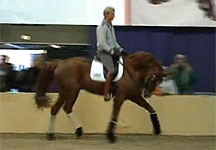The controversial training method rollkur will be investigated by the International Equestrian Federation (FEI), following the so-called “blue tongue” row that erupted three weeks ago.
Rollkur – or hyperflexion – has been a contentious issue for a number of years, and was last investigated by the FEI in 2006.
But three weeks ago the discussion was opened again following public outrage at a video clip of Swedish rider Patrik Kittel that was posted on YouTube. Patrik was filmed by a Danish journalist warming up his horse Watermill Scandic in Odense, Denmark using hyperflexion.
At one point, the horse hangs his tongue out of the side of his mouth and it appears to go blue.
Today, the FEI announced a condemnation of any training methods and practices contrary to horse welfare, requesting all stewards to use disciplinary measures — yellow cards — to prevent infringements of the rules from now.
But whether rollkur is actually against FEI rules is still subject to debate.
“And that is exactly what we need to clarify, we have realised much more needs to be done in this area,” said FEI veterinary director Graeme Cooke.
“Clearly, anything inappropriately done to excess is something we have concerns about. And there needs to be more clarity about rollkur — whether it is acceptable and to what level.”
The FEI will work with its partner, international equine charity World Horse Welfare, on the issue of hyperflexion.
World Horse Welfare chief executive Roly Owers told H&H: “There are issues with rollkur (hyperflexion) and the incident in Odense last month has brought this sharply into focus. We are happy to work with the FEI on this.
“However let us be clear that hyperflexion cannot cause a horse’s tongue to turn blue; much of the reaction around the You Tube video seems to imply this.”

